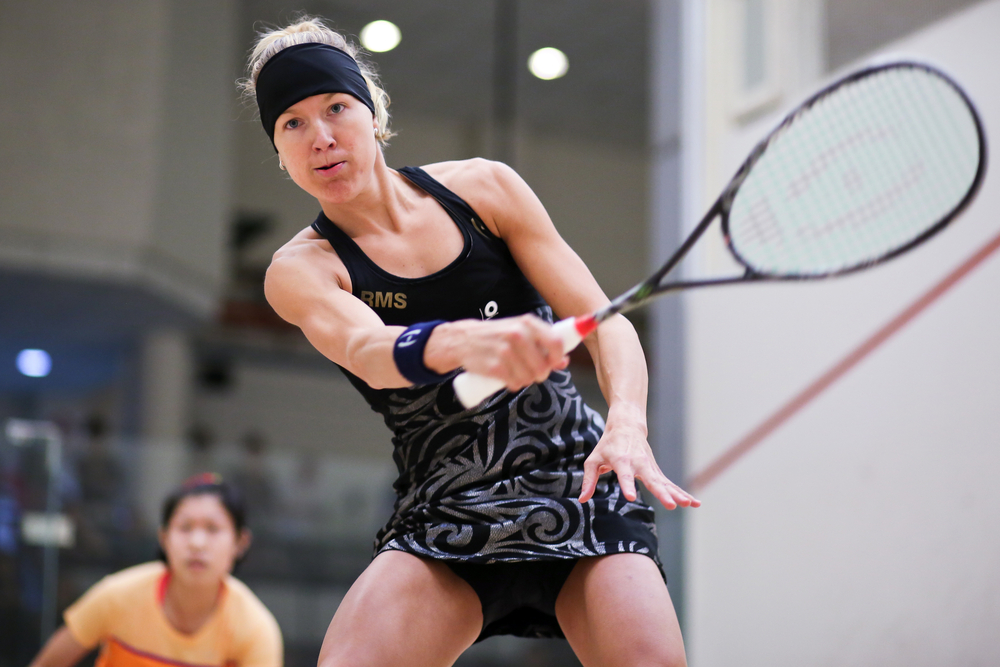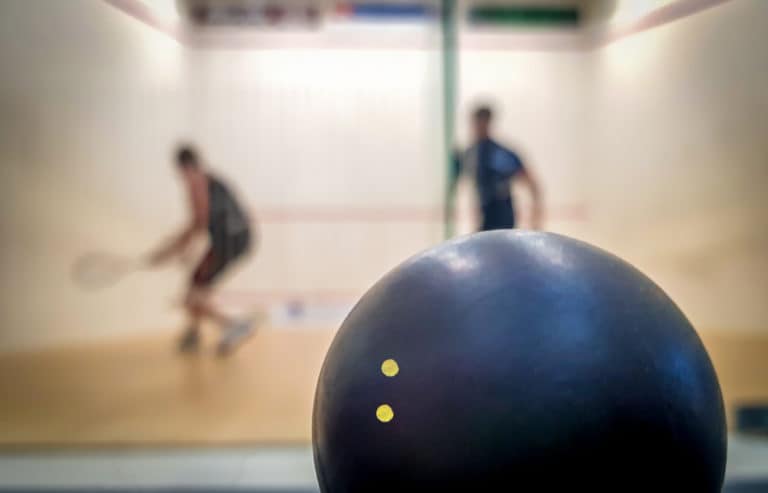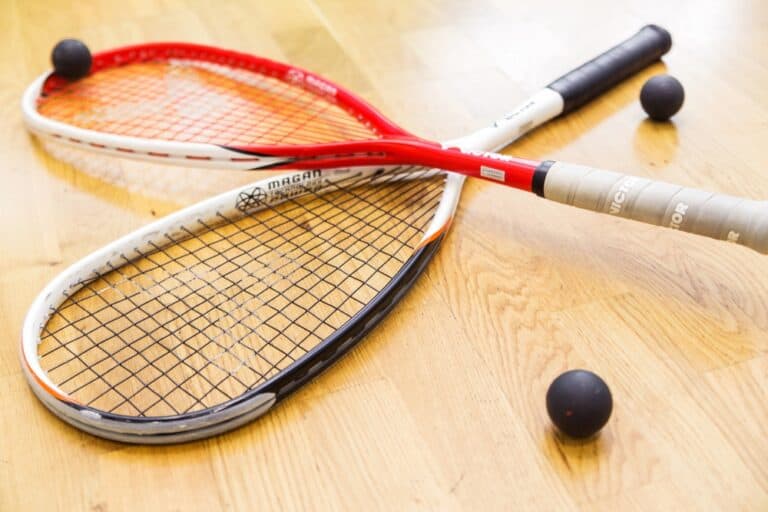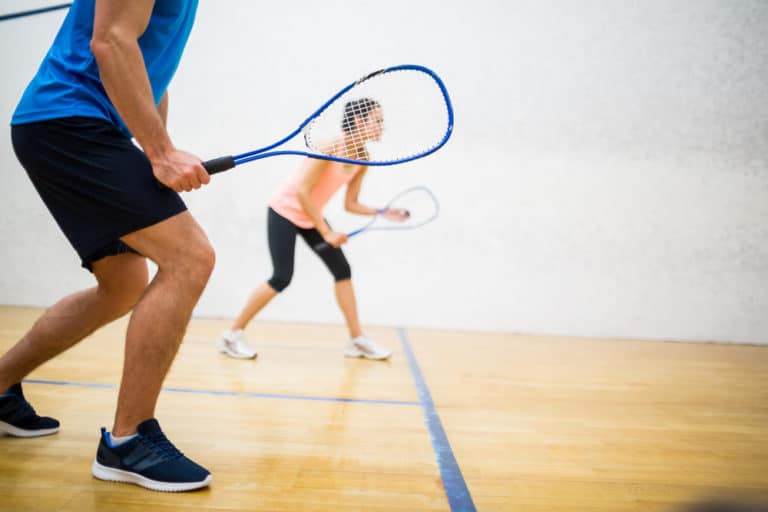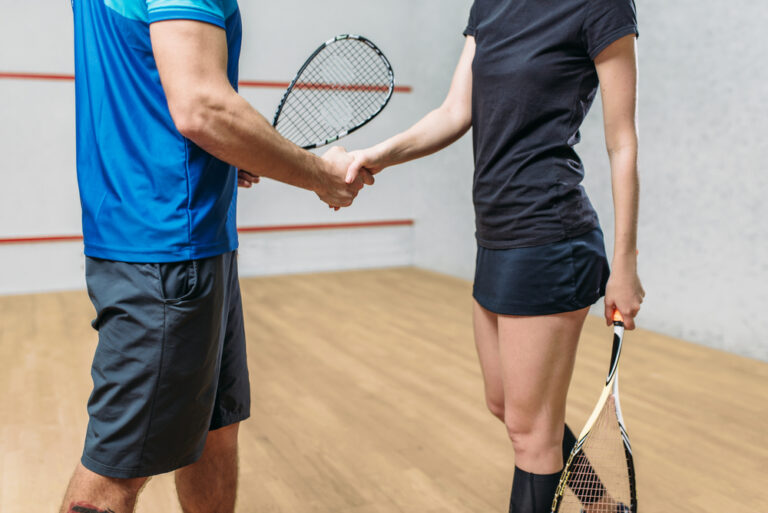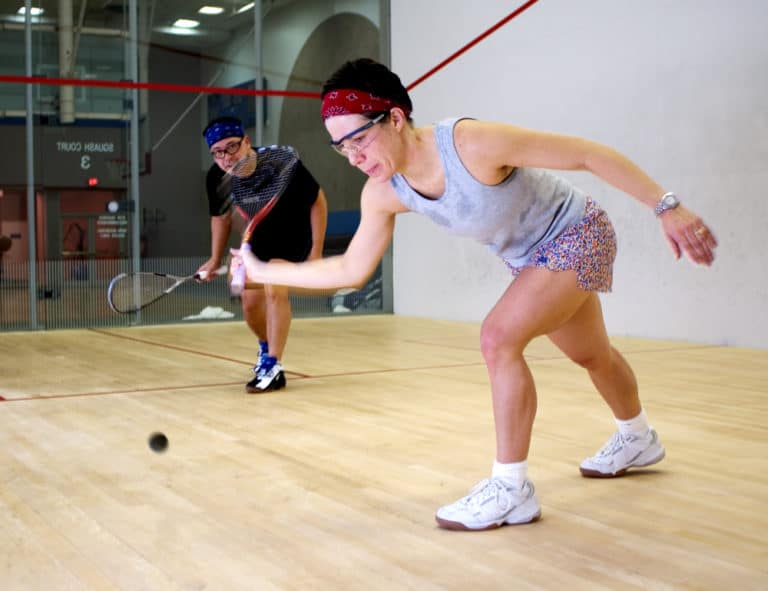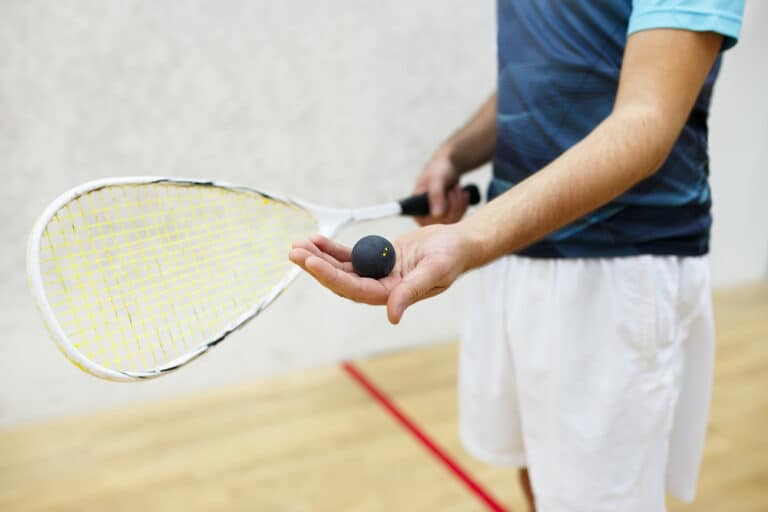Can Playing Squash Build Muscle?
There are roughly 8 000 types of sports globally, and for those who play sports, building muscle is part and parcel of the activity. However, not all sports are created equally, and the types of muscles built vary considerably. Some sports, like squash, involve lots of running around the court while chasing a ball. So while not actively benching weights, can playing squash build muscle?
Squash is a high-intensity sport that provides players with a “full-body” workout. Building muscle through playing squash is a given, and with some extra training techniques, you can further enhance muscle development during a squash game. Recovery after an intense game is critically important.
Squash is a high-movement sport where your legs constantly move to put you in the ideal spot. Below we’ll investigate what muscles you target while playing squash, how these muscles work, the pros and cons of building muscles by playing squash, and other health benefits squash illicits.
The Biomechanics Of Squash
Squash, like most sports, involves skill, strength, dexterity, and, most importantly, cardio. Running around the court after a small bouncy ball during bouts/rallies is no easy task, and if you’re new to the sport, you’ll soon realize that it is quite a hard workout.
(Particularly if you’re playing against an opponent better than you!)
Squash players utilize a full range of motion during a game that targets all the major muscle groups. Squash requires quick turns, powerful (yet controlled) shots of the forehand and backhand, quickly positioning your body, and sprinting to ad from the “T.”
All while dodging your opponent and trying to tire them out. Just thinking about it could make you perspire!
Below we’ll investigate the mechanisms behind muscle building in squash and the major muscles targeted.
What Muscles Do You Build While Playing Squash?
Squash involves a full-body workout with a lot of high-intensity running, and after a rousing game, you’re bound to feel it the next day. Below we’ll examine each of the major muscles affected when playing squash.
| Region of the body | Muscle group | Specific muscle | In layman’s terms |
| The shoulders girdle | Anterior Axio-appendicular muscles/Pectoral muscles | Pectoralis major, pectoralis minor, subclavius, and serratus anterior. | The pectorals, trapezoids, and deltoids. |
| Posterior axio-appendicular muscles | Extrinsic muscles: Trapezius, latissimus dorsi, levator scapulae, rhomboid major, rhomboid minor Intrinsic muscles: Deltoid, teres major, rotator cuff muscles (supraspinatus, infraspinatus, teres minor, subscapularis). | ||
| The arms | Upper arms | biceps brachii, brachialis, coracobrachialis, and triceps brachii. | The triceps, wrist flexors and extensors, and biceps. |
| Forearms | Superficial compartment: flexor carpi ulnaris, palmaris longus, flexor carpi radialis and pronator teres. Intermediate compartment: flexor digitorum superficialis Deep compartment: flexor digitorum profundus, flexor pollicis longus, and pronator quadratus. | ||
| The abdomen/core | Core | Rectus abdominis, transverse abdominis, multifidus, internal and external obliques, erector spinae, diaphragm, and pelvic floor muscles. | Abs, obliques, and spinal erectors. Lats, traps, and glutes are also part of your “core.” |
| The hip and legs | Iliopsoas group | Iliacus, psoas major, and psoas minor. | The hamstring, gluteals, and quadriceps. |
| Gluteal muscles | Gluteus maximus, gluteus medius, gluteus minimus, tensor fasciae latae, piriformis, gemellus superior, obturator internus, gemellus inferior, obturator externus, and quadratus femoris. | ||
| Hip adductors | Gracilis, pectineus, adductor longus, adductor brevis, adductor magnus, and adductor minimus. | ||
| Lower legs | anterior tibialis, gastrocnemius, and soleus. | Calf muscles. |
While playing a game of squash, you’ll engage most of these muscles through running, playing shots, and balancing.
How Do You Build Muscle Playing Squash?
While not all of the above muscles are constantly under strain, most are constantly at work during an intense squash game or training session.
Squash requires (almost) constant movement for around 30 to 40 minutes. During this time, your muscle groups are engaged for short bursts as you move back and forth, take a shot, regain balance, and move to the next point in the court.
In squash, before you can take a shot at the ball, you’ll need to first get to the ball.
Your legs are a critical part of a game of squash. As you move around the court, you work the propelling muscles in your legs and hone your stabilizing muscles as you make sharp twists and turns.
The average squash player runs approximately 0.9 miles in a game, while professional squash players may run up to 1.6 miles. An impressive distance in a court of only 32 by 21 feet. This running is usually in short bursts with short pauses in between.
Once you’ve finally reached the ball, the next step is to position yourself. Contorting into obscure positions while maintaining your balance puts all the focus on your core and stabilizing muscles.
At last, you’re ready to take the shot. The “strength” part of squash is not limited to how strong your arms are. As you take the shot, your core, legs, and stabilizing muscles assist in exerting force onto the ball.
Swinging your racket and driving the ball towards the wall helps you build arm strength and control.
You’ll have approximately 9 to 13 shots per rally in a game. How many rallies you play depends on the competitors involved.
While training to build more muscle for squash (while playing squash), your aim should be on endurance, flexibility, and, most crucial, cardiovascular fitness.
The Importance Of Resting After An Intense Squash Game
Exercise is fantastic when you’re actively tearing and fatiguing muscles. But to fully gain the benefits of your labors, you’ll need to recuperate your spent energy and allow your body some time to rest.
Failure to recuperate could lead to severe strain and damage to your body that will set you back for weeks or months.
Some of the best ways to recover and rest after a squash game include:
Stretching Before And After A Game
Stretching is an essential part of any exercise, especially one as intense as squash. Stretching reduces the amount of lactic acid which builds up during exercising, which reduces your recovery time and the “stiff” feeling after exercising.
Eating A Balanced Diet
Aside from physical exercise, what you put into your body is also critically important. During exercise, your muscles stretch and tear; as you rest, they heal and become stronger. A correct diet means that you supply your muscles with the amino acids and other nutrients they require.
Eating well also provides sufficient energy, so when you play a high-intensity game like squash, you have the energy to go further for longer.
Drinking Plenty Of Water
Aside from eating a healthy balanced diet, drinking enough water is of dire importance. Water is essential for our bodily functions, so by drinking enough water, we ensure that our bodies function optimally.
Resting Is Important
Although you might feel like you can “keep going all day,” you’ll do yourself an injustice. A time of rest between high-intensity exercising is critical because your body needs time to heal torn muscles, replenish its “stores,” and break down lactic acid.
Failure to properly recover after a squash game could hamper you by causing several different injuries, including:
- Ankle sprains
- Straining muscles and tendons
- Shoulder and joint injuries
- Tennis elbow
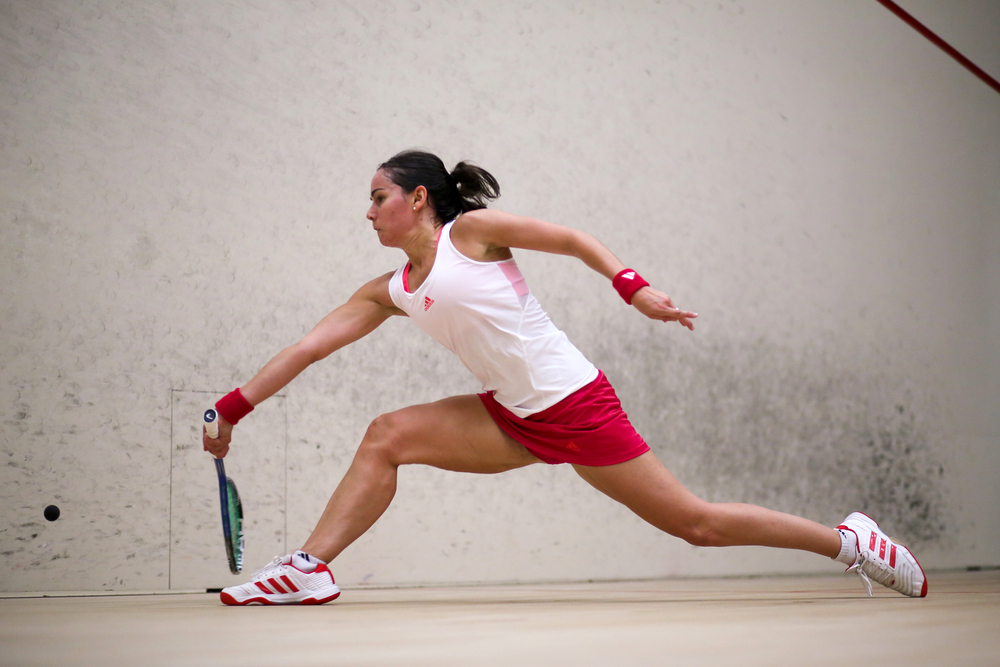
Are There Exercises In Squash To Improve Muscle Building?
Your performance in squash is related to more than your fitness level. Skill and experience are quintessential in any game. However, these factors come with playing the game, and in the early stages, fitness and good energy levels can carry you a far way.
Although playing squash for several hours is an incredible workout, you can further improve on the “bang-for-your-buck” by incorporating additional exercises to the squash game/training.
Some additional exercises include:
- Push-ups
- Sit-ups and crunches
- Sprints
- Lunges
- Sprints
There are several ways of incorporating these additional exercises into a squash session.
Pre-Game Squash Workouts
Similar to how the squash ball needs warming up, taking time before playing to do some exercises is a great way to train. These pre-game workouts include stretching, which helps prevent injuries during the game.
One benefit is that you burn off your “enthusiastic energy” before the game starts, so you must play more strategically. Plus, you’ll dip into reserves you did not realize you have (especially if you have a competitive streak).
The drawback of this method is that if you use too much energy, you might be too tired to play a squash game, so moderation is essential. Knowing your limits and operating within them is paramount to avoiding injuries.
Squash Workouts During The Game
This method only works if your training partner agrees to it. Before starting, decide on when to incorporate the training. A good time is after someone scores a point. You could also decide to exercise between games.
Whatever your timing, once the “start exercise criteria” are met, you could run between the back and front wall 5 to 10 times (depending on your capacity), followed by push-ups/sit-ups, etc.
Once the extra exercise is completed, return to the game until you meet the exercise criteria again.
The drawback to this method is that you’ll have a much longer squash game, or you won’t play until the usual score.
An alternative method is to turn your squash game into a fitness session. You’ll usually practice a predetermined number of shots, then run between the back and front wall between 5 and 10 times, then do a set of push-ups (depending on your abilities, but multiples of 5 or 10 is a good start).
Once you’re finished with the push-ups, you’ll return to practicing shots (the same or different). After those, the running, followed by sit-ups, etc.
This method is especially great if you’re playing alone as you set your rules and pace for each leg of the training.
Squash Workouts After The Game
A good way to warm down is to play a round of squash and do some extra strength workouts afterward.
The benefit would be that you’re getting in a full game of squash without the pre-game workout fatigue. However, the disadvantage is you might be too tired or uninspired to do the exercise afterward.
What Are The Pros And Cons Of Playing Squash To Build Muscle
Squash is a marvelous sport for building muscles. Below we’ll investigate some of the advantages and disadvantages of muscle building while squash playing.
The Advantages Of Building Muscle Through Squash
- Squash is a holistic exercise, meaning you don’t target a specific set of muscles. You use “natural” movements, so your entire body receives a workout.
- Playing squash is a phenomenal way to improve cardiovascular health simultaneously with muscle growth.
- Squash keeps your mind alert. Since you’re constantly moving around, looking for the ball, predicting what your opponent will do, and trying to outplay them, your mind remains active and alert. Not only does your body get a workout, but your mind also does.
- Playing squash is a great way to burn fat through high-intensity exercise. Although squash games are short, they push your body, so the amount of calories you burn equals a lower intensity exercise over a longer period.
The Disadvantages Of Building Muscle Through Squash
- Squash requires considerable fitness before you begin to benefit and develop muscles. You won’t receive the fruit if you can’t go for a full game. Squash is great, but you’ll need to build up to it.
- Squash is not as effective as weight lifting in building muscles, particularly upper body muscles.
- Squash involves a tremendous amount of cardio, so the chances of your body processing muscle to fuel its needs are high unless you maintain a healthy diet.
- Usually, squash benefits your dominant hand and arm. Although two-handed shots are not illegal, they are usually uncommon, so your other hand does not receive the same “attention” as your dominant.
- Minor injuries are relatively common, especially sprains and twists. These mild injuries can still hamper you with longer recovery times, resulting in game-time “lost.”
What Are Some Further Health Benefits Of Playing Squash?
Aside from building muscles while playing squash, you receive additional benefits when you keep up with training and matches.
The Secret To Squash Is Cardio, Cardio, Cardio
Your lung capacity, diaphragm strength, and cardiac (heart) muscle strength are essential to sufficient cardiovascular fitness. Squash targets these other muscle types.
While other muscles in your body are important for squash, if you have poor cardio fitness, you won’t progress far.
Aside from the physical power you need to get around the court, you’ll need to put on a burst of speed, quickly position yourself, use your strength to drive the ball, and then carry on running. If you lack cardio fitness, you’ll quickly be left by the courtside huffing and puffing.
The superb news is that even if your cardio is atrocious, you’ll begin to feel the difference with a few squash rounds. Keep at it, and your cardio will become legendary, provided you’re willing to put in the hard work.
Squash Improves Hand-Eye Coordination
The other side to the fitness coin is the skill involved. As you practice and participate in squash games, your hand-eye coordination, strategic thinking, balance, and court awareness improves.
Although these attributes are a marvelous boon on a squash court, their real-life applications are also sound.
Improved coordination and balance assist you in all tasks, while logic and heightened awareness could help you avoid dangerous situations (things falling, walking into a bad area, etc.).
Squash Is A Social Sport, So Fitness Is Easier
Another significant benefit of playing squash is that it is a social sport, which becomes enjoyable the more you play. This social and “fun” factor makes building muscles and fitness a pleasant experience and a less arduous slog to get fit, healthy, and strong.
Conclusions
Squash is a marvelous sport. Not only do you get a full-body workout, you build healthy cardiovascular fitness, improve hand-eye coordination, improve your general awareness, and begin thinking strategically. Although building muscles while playing squash is fantastic, it is not without some drawbacks. Squash, however, remains a great activity to have fun with and exercise simultaneously.
References
- https://prezi.com/awdh-xisw7ol/biomechanics-in-squash/
- https://stretchcoach.com/articles/stretches-for-squash/
- https://www.kenhub.com/en/library/anatomy/shoulder-muscles
- https://www.mydr.com.au/sports-fitness/hip-and-thigh/
- https://www.verywellhealth.com/lower-leg-anatomy-3119329
- https://www.menshealth.com/fitness/a35307843/core-muscles/
- https://teachmeanatomy.info/upper-limb/muscles/upper-arm/

